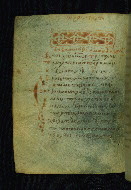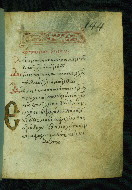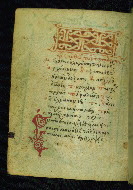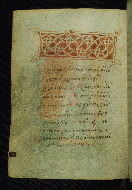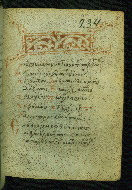Home > Digitized Walters Manuscripts
This document is a tranformation of a TEI P5 XML manuscript description incorporating images. If you have trouble reading special or non-Latin characters on this page, please make sure you have appropriate Unicode fonts installed and an up-to-date web browser.
Walters Ms. W.534, Book of Hours
Browse images (Browse images in a new window) | TEI in XML format
W.534
Book of Hours
Vernacular: Ὡρολόγιον σὺν Θεῷ ἁγίῳ περιέχον ἅπασαν ἀκολουθίαν τοῦ νυχθημέρου
Illustrated Books of Hours in Greek are extremely rare. This example is also of interest because its miniatures show interaction between the Late Byzantine and Gothic artistic styles. It may have been copied on the island of Crete, which in the fifteenth century was ruled by Venice.
Mid-15th century CE
Eastern Mediterranean
Book
Devotional
The primary language in this manuscript is Greek, Ancient (to 1453).
Parchment
Medium-weight parchment
Foliation: 260
Foliated in black ink, upper right rectos
Formula: 1(8,-1,-2), 2-4(8), 5(8,-1), 6-9(8), 10(10,-3), 11-17(8), 19(8,-7), 20(8,-6), 21(8), 22(10,-3,-7), 23-32(8), 33(6), 34(10)
Catchwords: None
Signatures: Written by the scribe; some visible on the bottom right corner of the first folio of each quire; many are lost
Comments: Quires begin on fols. 1(1), 7(2), 15(3), 23(4), 31(5), 38(6), 46(7), 54(8), 62(9), 70(10), 79(11), 87(12), 95(13), 103(14), 111(15), 119(16), 127(17), 135(18), 143(19), 150(20), 157(21), 165(22), 173(23), 181(24), 189(25), 197(26), 205(27), 213(28), 221(29), 229(30), 237(31), 245(32), 253(33), 259(34)
7.3 cm wide by 9.2 cm high
3.5 cm wide by 6.0 cm high
- Columns: 1
- Ruled lines: 15
- Title: Book of Hours
- Contents: Fols. 1r–64v: Matins; fols. 65v–75v: Prime; fols. 77v–92r: Terce; fols. 93r–105v: Sext; fols. 106v–119r: None; fols. 119r–134r: Typika; fols. 134v–143r: Refectory; fols. 144r–157v: Vespers; fols. 158v–205v: Compline; fols. 206v–233v: Nocturns; fols. 234r–250v: Saturday Nocturns; fols. 251r–260r: Canon at the Separation of the Soul from the Body
- Hand note: One hand throughout; the scribe did not sign this manuscript, but he can be identified, through palaeographic comparison, with a Nicholas who copied the present Ms. Vatic. gr. 1143 in 1449 CE
- Decoration note: Seventeen full-page miniatures; light pen-drawn ornamental headpieces, headbands, and initials throughout; rubrics in red; text in brown ink
fol. 1r:
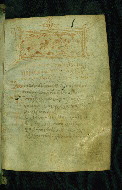
- Title: Book of Hours title page
- Form: Decorated headpiece
- Comment:
The title reads "Book of Hours, with Holy God, Containing All the Services of the Night and the Day."
The ornamented headpiece is drawn in the same red ink as the titles and rubrics and must be the work of the book's scribe.
fol. 20v:
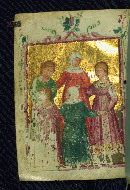
- Title: Israelite women dancing
- Form: Full-page miniature
- Text: Exodus 15:2-18
- Comment:
The morning prayer service (Matins) comprises nine odes (canticles), poetic excerpts from various books of the Bible. Each of them is introduced in this manuscripts by a full-page miniature. The one here precedes the first ode, taken from the Book of Exodus. The Israelite women are shown dancing in a circle to celebrate Israel's crossing of the Red Sea (Exodus 14:5-31). Their high-girded dresses reflect fifteenth-century fashion.
fol. 24r:
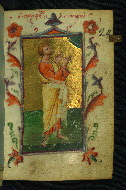
- Title: Moses Praying
- Form: Full-page miniature
- Text: Deuteronomy 32:1-43
- Comment:
The inscription reads "The Prophet Moses."
This miniature introduces the second ode (canticle). Even though this ode was originally recited by Moses "in the hearing of the whole assembly of Israel" (Deuteronomy 31:30), the prophet is depicted alone, his arms stretched out in prayer and his face turned toward heaven. He thus sets an example for the reader, who is to recite the ode as a morning prayer.
fol. 32v:
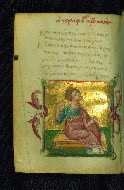
- Title: The Prophet Habakkuk
- Form: Half-page miniature
- Text: 1 Samuel 2:10 (on this page), Habakkuk 3:2-19 (on the following pages)
- Comment:
The inscription reads "The Prophet Habakkuk."
The text on this page is the end of Ode 3, the frontispiece miniature to which is lost. Habakkuk is portrayed as the author of the following, fourth ode. His face is turned upward as he addresses the Lord. The scroll in his hand represents his written prophecy.
fol. 36r:
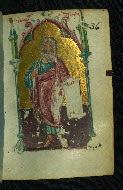
- Title: The Prophet Isaiah
- Form: Full-page miniature
- Text: Isaiah 26:9-20
- Comment:
The inscription reads "Isaiah the Prophet."
This miniature introduces Ode 5. Its author, Isaiah, is shown holding an open scroll, perhaps originally inscribed with the ode's first words (the pigments have now flaked).
fol. 38v:
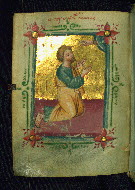
- Title: Jonah Praying
- Form: Full-page miniature
- Text: Jonah 2:2-9
- Comment:
The inscription reads "The Prophet Jonah."
This miniature illustrates Ode 6, the prayer that Jonah spoke to the Lord from the belly of the fish (Jonah 1:17). God is symbolically represented by a hand reaching out from heaven. The fish is not in evidence.
fol. 40v:
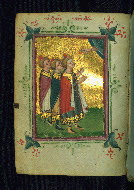
- Title: The Three Jews in the Fiery Furnace
- Form: Full-page miniature
- Text: Apocrypha: Prayer of Azariah
- Comment:
The inscription reads "The Three Children."
This miniature introduces Ode 6, a text not present in the Hebrew Bible and found in the Greek Old Testament after Daniel 3:23. It shows the three young Jews thrown into a blazing furnace as punishment for refusing to worship a golden statue set up by the Babylonian king Nebuchadnezzar (Daniel 3:1-23) and then miraculously saved from the fire (Daniel 3:27). "So the men were bound, still wearing their tunics, their trousers, their hats and their other garments" (Daniel 3:21). The small red hats seen in this miniature were traditionally considered Persian headgear and, thus, appropriate for Jews living in Babylon. The text on the following pages is the Jews' prayer for deliverance.
fol. 46r:
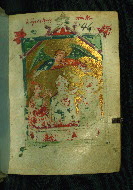
- Title: The Three Jews in the Fiery Furnace
- Form: Full-page miniature
- Text: Apocrypha: Song of the Three Jews
- Comment:
The inscription reads "The Three Holy Children."
Like the preceding Ode 7, the text illustrated here is not part of the Hebrew Bible and is only found in the Greek version of the Book of Daniel. Ode 8 is the song of thanksgiving that the three young Jews offered to the Lord after escaping harm (Daniel 3:27). An angel is shown shielding them from the flames. Their hands are raised in prayer. The furnace is somewhat schematically represented as a box with four openings for stoking the fire.
The pigments have mostly fallen off, revealing the preliminary drawing that guided the artist.
The word "holy" in the labeling inscription signals that the Three Jews are venerated as saints by the Eastern Orthodox Church. Their feast day is December 17, that same day as that of the prophet Daniel.
fol. 50v:
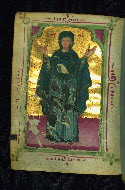
- Title: The Virgin Mary praying
- Form: Full-page miniature
- Text: Luke 1:46-55
- Comment:
The inscription reads "Mother of God."
The last, ninth ode (canticle) consists of two parts, both taken from the Gospel of Luke. The passage introduced by this miniature are Mary's words spoken during her meeting with Elizabeth (Luke 1:39-45). The Virgin's hands are raised in a gesture of prayer.
fol. 52r:
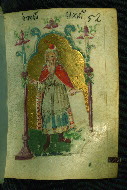
- Title: Zechariah
- Form: Full-page miniature
- Text: Luke 1:68-79
- Comment:
The inscription reads "The Prophet Zechariah."
The second part of Ode 9 is the thanksgiving prayer of Zechariah, father of John the Baptist. Zechariah is shown here in the dress of a priest from the Temple of Jerusalem. His ritual headgear is quite similar to the Persian hats worn by the three Jews on fols. 40v and 46r.
fol. 65r:
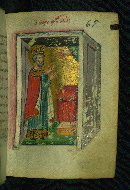
- Title: King David Praying
- Form: Full-page miniature
- Comment:
The inscription reads "The Prophet David."
Given that each of the prayer hours (Prime, Terce, Sext, None, Vespers, Compline) begins with a series of psalms, it was appropriate to portray at their beginning King David, traditionally considered the author of the Psalter. This miniature serves as frontispiece to Prime, which begins on the next page with the call "Come, let us worship..." and the text of Psalm 5. David is shown praying in front of an altar. God is symbolically represented by a hand reaching out from heaven.
The room in which David stands is rendered in perspective, as a three-dimensional rectangular object. This is unusual for Byzantine art but quite common in the late Gothic art of the medieval West.
fol. 76r:
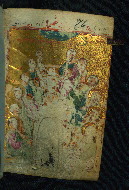
- Title: Pentecost
- Form: Full-page miniature
- Comment:
The inscription reads "The Pentecost."
Christ's disciples, with Peter and Paul in the center, are seated on a semicircular bench. Red fiery rays fall from heaven to their heads. Terce is introduced by an image of Pentecost because the Holy Spirit was traditionally believed to have descended upon the apostles at the third hour of the day. A short hymn on fol. 86r reads: "Lord who in the third hour sent down Υour most holy Spirit to the apostles, do not withhold It from us, O Goodly One, but send it again toward us who pray to You."
fol. 77v:
fol. 85v:
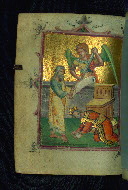
- Title: The Penitence of David
- Form: Full-page miniature
- Text: Psalm 51 (LXX Psalm 50)
- Comment:
Psalm 50, a widely known song of penitence, was traditionally illustrated in many Psalters (compare W.733, fol. 25r). This tradition carried over into the present Book of Hours, where the last of the three psalms used in Terce is accompanied by a separate miniature. This image illustrates the circumstances under which the psalm was originally recited: when the prophet Nathan came to David to rebuke him after he had gone in to Bathsheba (2 Samuel 11:2-12:15). An angel hovers over David, holding in his hand an unsheathed sword as a reminder that God punishes sin. An empty throne is seen behind the prostrate, penitent king. Nathan's scroll stands for the parable he told David (2 Samuel 12:1-4).
fol. 92v:
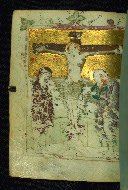
- Title: The Crucifixion
- Form: Full-page miniature
- Text: Sext
- Comment:
The inscriptions read "The King of Glory" (on the tablet on top of the cross), "Jesus Christ," "Mother of God," and "John."
Jesus was believed to have been crucified in the sixth hour of the day. Accordingly, a short hymn on fol. 99r of the present manuscript begins "You who were nailed to the cross on the sixth day [of the week] and at the sixth hour [of the day]" The image here serves as the frontispiece for Sext and shows the dying Savior flanked by his mother and closest disciple, with the wall of Jerusalem in the background.
The details of the faces of the Virgin and Jesus have been partly re-inked to compensate for the pigment lost through flaking.
fol. 106r:
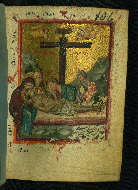
- Title: The Lamentation
- Form: Full-page miniature
- Comment:
The inscription reads "The Deposition."
The dead body of Christ is laid on a slab, to be anointed before burial. This is a frontispiece to None, the ninth prayer hour, includes the following hymn (fol. 113r): "You who at the ninth hour tasted for our sake death in the flesh, deaden the desire of our flesh, Christ O God, and save us."
fol. 119r:
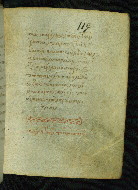
- Title: Title of the Typika
- Form: Ornamented headband
- Text: Typika
- Comment:
This page contains the end (last verses of the concluding prayer) of the text for Sext and the title of the Typika, a supplementary prayer office between Sext and None.
fol. 143v:
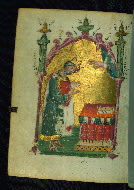
- Title: King David Praying
- Form: Full-page miniature
- Text: Vespers
- Comment:
The book upon the altar before the praying David is probably the book of psalms that he composed. Vespers begin on the following page with Psalm 104 (LXX Psalm 103).
The pointed arch of the decorative frame around the miniature is a typical element of the Gothic style current in western Europe at the time when this manuscript was made.
fol. 144r:
fol. 158r:
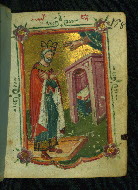
- Title: King David Praying
- Form: Full-page miniature
- Text: Compline
- Comment:
The inscription reads "The Prophet David."
David is shown praying in front of a structure that resembles a small chapel. Compline begins on the next page with Psalm 4.
fol. 158v:
fol. 206r:
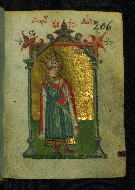
- Title: King David Praying
- Form: Full-page miniature
- Text: Nocturns
- Comment:
The inscription reads "The Prophet David."
fol. 206v:
fol. 234r:
The binding is not original.
Greek, ca. sixteenth-seventeenth century; green patterned silk (now very worn and soiled) over flush-grooved wooden boards; paper pastedowns (probably added later); raised endbands; flat spine; traces of clasps on the back cover
Henry Walters, Baltimore, by purchase before 1931
Walters Art Museum, 1931, by Henry Walters' bequest
Parpulov, G.R. “A Catalogue of Greek Manuscripts at the Walters Art Museum.” Journal of the Walters Art Museum 62 (2004): pp. 71-189, at pp. 126-131
Ševčenko, N.P. "The Walters' Horologion." Journal of the Walters Art Museum 62 (2004): pp. 45-59
Principal cataloger: Parpulov, Georgi R.
Cataloger: Walters Art Museum curatorial staff and researchers since 1934
Editor: Herbert, Lynley
Copy editor: Dibble, Charles
Conservators: Owen, Linda; Quandt, Abigail
Contributors: Bockrath, Diane; Emery, Doug; Joyal, Stephanie; Noel, William; Tabritha, Ariel; Toth, Michael B.
The Walters Art Museum
Licensed for use under Creative Commons Attribution-NonCommercial-ShareAlike 3.0 Unported Access Rights, http://creativecommons.org/licenses/by-nc-sa/3.0/legalcode. It is requested that copies of any published articles based on the information in this data set be sent to the curator of manuscripts, The Walters Art Museum, 600 North Charles Street, Baltimore MD 21201.
